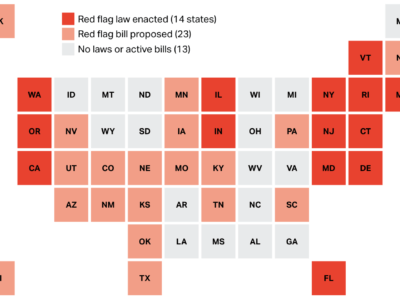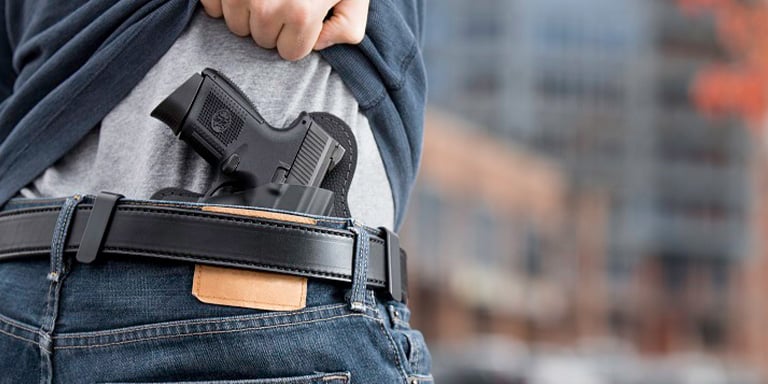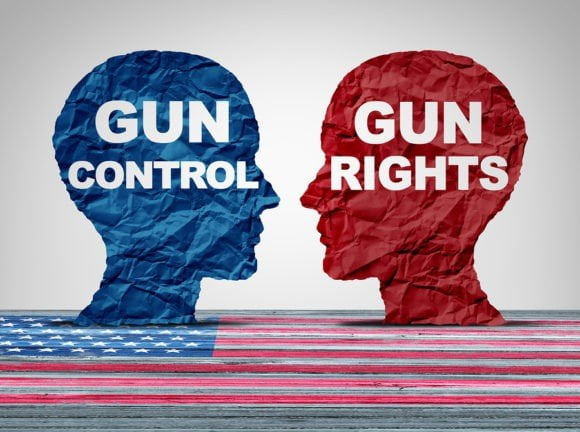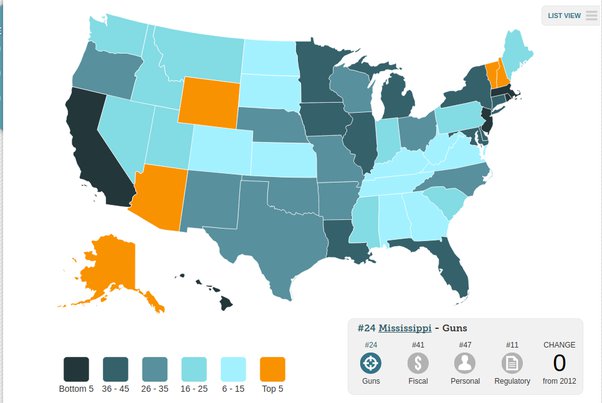Red Flag Laws: An Overview of Extreme Risk Protection Orders
Red flag laws, also known as extreme risk protection orders (ERPOs), are statutes that allow courts to temporarily remove firearms from individuals who show warning signs of violence. These laws aim to prevent gun violence by enabling law enforcement and family members to petition a judge to suspend a person’s access to guns if they exhibit dangerous behavior.
Red flag laws have become a topic of fierce debate in recent years. Proponents argue they can save lives by preventing mass shootings and suicides. Opponents contend they violate due process rights. Despite the controversy, a growing number of states have passed red flag laws since the 2018 Parkland school shooting.
What Are Red Flag Laws?
Red flag laws, or ERPOs, provide a legal process to temporarily restrict firearms access for individuals who pose a potential danger to themselves or others. They aim to balance public safety and Second Amendment rights.
These laws allow law enforcement officers, and in some states, family or household members, to petition a judge for a protection order against an individual exhibiting threatening behavior. If a judge finds evidence that the person poses “significant danger” of injuring themselves or others soon, the judge can issue an order to:
- Prohibit the person from purchasing or possessing firearms
- Require them to surrender their firearms to law enforcement
The protection orders typically last up to one year. The person can petition the court to have their firearms returned before the order expires.
Key Provisions of Red Flag Laws
While specifics vary by state, red flag laws have some core common provisions:
- Allow law enforcement officers to petition for an ERPO
- Allow family/household members to petition in some states
- Require credible evidence of a dangerous threat to self or others
- Provide due process protections (hearing before a judge)
- Require surrender of all firearms in respondent’s possession
- Establish a system for returning firearms after the order expires
History of Red Flag Laws
Red flag laws originated from domestic violence restraining orders. These court orders prohibited domestic abusers from possessing firearms.
Indiana enacted the first red flag law focused on broader gun violence prevention in 2005. Other states gradually followed. However, red flag laws gained momentum after the 2018 mass shooting at Marjory Stoneman Douglas High School in Parkland, Florida.
Since Parkland, nearly 20 states and DC enacted ERPO laws. With bipartisan support, red flag laws are one of the few gun reforms to advance in state legislatures recently. However, some conservative states have strongly opposed them.
The federal government does not have red flag laws, but federal legislation has been proposed. Some experts say states are better positioned to implement ERPOs now. If a national red flag law passed, states could still maintain their own stronger laws.
Red Flag Laws by State
Here are the states with red flag laws as of October 2023:
- California (2016)
- Colorado (2019)
- Connecticut (1999)
- Delaware (2018)
- District of Columbia (2020)
- Florida (2018)
- Hawaii (2020)
- Illinois (2019)
- Indiana (2005)
- Maryland (2018)
- Massachusetts (2018)
- Nevada (2019)
- New Jersey (2019)
- New Mexico (2020)
- New York (2019)
- Oregon (2017)
- Rhode Island (2018)
- Vermont (2018)
- Virginia (2020)
- Washington (2016)
How Red Flag Laws Work
Red flag laws follow a general process, with some variations state-by-state:
1. Petition Filed
The law enforcement officer or family/household member files a petition to the court and presents evidence that the respondent poses a significant danger. This initiates the ERPO court proceedings.
2. Ex Parte Hearing
An emergency ex parte hearing is held, often on the same day or within 24 hours. If the judge finds probable cause, a temporary ERPO is issued before the full hearing.
3. Temporary Order
The court issues a temporary ERPO, which prohibits the respondent from having firearms for a short period, typically 14-21 days. Police can then remove guns.
4. Full Court Hearing
Within the temporary order period, a full hearing is held where the respondent can participate and present evidence. If the judge finds clear and convincing evidence that the person is a “significant danger,” a final ERPO will be issued.
5. Final ERPO
A final ERPO prohibits gun possession/purchases for up to one year. The respondent must surrender all firearms. Police enforce the order.
6. Petition to Terminate Order
The respondent can petition once during the order term to have it terminated. If the judge rejects the petition, the order remains in effect. When the order expires, firearms are returned.
Who Can Petition for an ERPO?
In most states, law enforcement officers can petition for an ERPO. This allows police to act if they encounter threatening behavior during a domestic dispute, mental health crisis, or in other contexts.
Around 15 states also allow family or household members to petition. This empowers parents, spouses, siblings, roommates, etc. to act if a loved one displays warning signs of violence.
Few states allow medical professionals, school officials, or other parties to petition. Advocates say allowing more petitioners beyond just law enforcement can improve prevention and early intervention. But opponents argue the law is more open to abuse.
Evidentiary Standards
To issue an ERPO, the judge must find evidence that the person poses a danger. But states have different standards of proof:
- Probable cause (lower threshold) – about 15 states
- Clear and convincing evidence (higher standard) – about 10 states
Supporters favor the higher standard to balance rights. Critics say even the higher standard is still lower than criminal law’s “beyond reasonable doubt.”
Due Process Concerns with Red Flag Laws
Perhaps the biggest debate around red flag laws is whether they provide sufficient due process protections. Critics raise civil liberties concerns:
- Second Amendment – temporarily revoking firearms rights before any criminal conviction
- Fourth Amendment – seizing property without high evidentiary standards
- Fifth Amendment – denying the right of accused persons to defend themselves at ex parte hearing
- Fourteenth Amendment – depriving property without due process
Supporters counter that ERPOs do provide due process:
- Court hearing before a judge
- Respondent can participate in a full hearing
- Clear evidence required
- Time-limited order
- Option to terminate the order
But debates persist over appropriate balance. Some states have amended laws to heighten due process protections and ease concerns.
Right to Counsel
Most concerning to critics is that many laws do not guarantee the respondent a right to counsel, as the proceedings are civil rather than criminal. Advocates say the right to counsel is essential.
Colorado became the first state to provide counsel for indigent respondents. A few others followed. More states are considering this reform.
Effectiveness of Red Flag Laws
Do red flag laws work to prevent gun violence? Effectiveness is not yet proven. Some key considerations:
- Research is still limited – Most laws are fairly new, so robust data is lacking. But early studies show promise.
- Success depends on implementation – How vigilant officials are in pursuing orders affects outcomes.
- Prevention is hard to quantify – It’s impossible to count shootings that never occurred. However, evidence suggests ERPOs help reduce deaths.
- Measuring life savings – One strong indicator is research showing decreases in firearm suicides after ERPO adoption.
While not definitive, early research indicates red flag laws likely provide public health benefits in preventing tragedies. Most experts believe well-crafted and properly implemented ERPO laws can save lives.
Challenges & Concerns with Enforcement
Red flag laws aim to balance individual rights and public safety. But some challenges complicate real-world enforcement:
Reluctance to Report Loved Ones
Family members may be reluctant to petition against loved ones struggling with mental illness or other issues. Starting legal proceedings against them seems extreme. Trying to handle problems informally may risk greater harm.
Burden on Law Enforcement
Processing ERPO petitions creates more responsibilities for police and courts. That strains already overloaded systems. Rural counties with few officers face greater difficulties enforcing orders and seizing hundreds of guns.
Noncompliance & Follow-Up
Some individuals under ERPOs may refuse to surrender firearms. Enforcing compliance takes manpower. Budget constraints can limit follow-up monitoring. Background loopholes check gun laws to buy guns from private sellers despite ERPO.
Cross-State Issues
With different laws in each state, enforcement problems arise when people travel across state lines. Some states are discussing cross-state reciprocity agreements to enforce out-of-state orders.
Opposition to Red Flag Laws
Despite bipartisan support, some lawmakers strongly oppose red flag laws. Opposition stems primarily from arguments that they:
– Infringe on Constitutional Rights
Critics argue that ERPOs deprive individuals of core Constitutional rights – Second Amendment, Fourth Amendment, and due process rights – before any criminal conviction.
– Lack of Due Process Guarantees
Procedural concerns persist around ex parte hearings, evidentiary standards, and lack of counsel for respondents in most states.
– Open Door to Abuse
Some fear disgruntled family members or others could file false or harassing petitions, using ERPOs to disarm lawful gun owners.
– Won’t Stop Violence
Other skeptics contend ERPOs just take guns temporarily. They believe mental health reforms would be more effective to prevent violence long-term.
While support is growing, red flag laws will likely continue facing legal challenges from groups arguing the laws violate Constitutional protections.
Future Outlook & Directions
The future of red flag laws remains somewhat uncertain. Some potential directions include:
- More states adopting ERPO laws, following the trend of bipartisan support
- States expanding/strengthening laws, like providing counsel and cross-state enforcement
- Pushback from opponents in conservative states
- Federal legislation was proposed, but unclear if it could pass currently
- Courts weighing challenges to red flag laws on Constitutional grounds
- Research continuing to evaluate the effectiveness of violence prevention
- Law enforcement training improving enforcement practices
- Cultural norms shifting to view gun violence prevention more favorably
Overall, momentum favors more red flag laws at the state level and stronger enforcement nationally. However, debates will persist between gun rights and gun safety advocates.
Red Flag laws for gun control
refer to laws that allow law enforcement, and in some cases family members, to petition a court to temporarily remove firearms from individuals who may present a danger to themselves or others. Red flag laws aim to balance public safety and Second Amendment rights. Critics argue these laws undermine due process, while supporters say they can help prevent mass shootings and gun suicides.
Red Flag Rules for Financial Institutions
The red flags rule for financial institutions requires banks, credit card companies, and other creditors to develop identity theft prevention programs to detect possible incidents of identity theft in new or existing accounts. Known as the Red Flags Rule, it outlines how covered entities must have procedures to identify patterns, practices, or specific activities that could indicate identity theft.
Red Flag Rules in Cyber Security
In cybersecurity, a red flag is an indicator that a system or network may be compromised or vulnerable. Red flags can include things like unusual traffic patterns, files being accessed that shouldn’t be, users accessing systems they don’t normally use, etc. IT security professionals watch for these red flags and investigate them further to determine if malicious activity is occurring and attempt to prevent breaches or data loss. The presence of red flags prompts additional scrutiny and safeguards.
Conclusion
Red flag laws stir fierce debate but save lives. When carefully crafted and properly enforced, extreme risk protection orders can prevent tragedies. However, ensuring due process and avoiding abuse remain challenges. Getting the details right – strong judicial oversight, fair procedures, right to counsel – bolsters effectiveness and builds support. While not a singular solution, ERPOs are a proven tool for temporarily restricting firearms from individuals exhibiting dangerous warning signs, before it’s too late.
FAQs;
Q1: What does a red flag law do?
Red flag laws, also called extreme risk protection orders (ERPOs), create a legal process to temporarily suspend a person’s access to guns if they show warning signs of violence. ERPOs aim to prevent gun violence by enabling courts to separate firearms from high-risk individuals during a mental health crisis.
Q2: What are common objections to red flag laws?
Opponents argue red flag laws infringe on Constitutional rights – Second Amendment, due process, etc. Some also fear the laws could enable false or harassing petitions. Procedural concerns persist around ex parte hearings, evidentiary standards, and counsel access.
Q3: Which states have passed red flag laws?
As of late 2023, around 19 states and the District of Columbia have passed red flag laws, including Colorado, Florida, Hawaii, New York, California, and others. Most laws were passed after the 2018 Parkland school shooting.
Q4: Who can petition for a gun violence restraining order?
In most states, law enforcement officers can petition. Around 15 states also allow petitions from family/household members concerned about a loved one. Some states allow petitions from medical professionals, educators, and coworkers.
Q5: How long do gun violence restraining orders last?
Most extreme risk protection orders last up to one year initially. The person can petition once during that term to have the order terminated early. Orders can sometimes be renewed after the first year, depending on state law.
Q6: What do red flag gun laws mean?
Red flag laws allow courts to temporarily remove guns from people deemed dangerous.
Q7: Are red flag laws effective?
Red flag laws have shown some effectiveness in reducing gun deaths, but research is still limited.
Q8: What rights do red flag laws Violate?
Critics argue red flag laws violate the right to due process and the 2nd Amendment right to bear arms.








